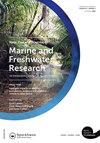A preliminary estimate of the contribution of coastal blue carbon to climate change mitigation in New Zealand
IF 1.7
4区 环境科学与生态学
Q3 FISHERIES
New Zealand Journal of Marine and Freshwater Research
Pub Date : 2023-09-13
DOI:10.1080/00288330.2023.2245770
引用次数: 0
Abstract
ABSTRACTThe scale at which New Zealand is currently storing and sequestering blue carbon, and could create additional blue carbon via restoration, has been unclear. Here, we calculate a preliminary estimate for the current extent of three key blue carbon ecosystems (saltmarshes, mangrove forests and seagrass meadows), their carbon stocks and their carbon sequestration rates using the best available data to provide a preliminary estimate of blue carbon in New Zealand. We also use local examples to explore opportunities to create additional blue carbon. Based on the available literature, we estimate the current extent of New Zealand’s blue carbon ecosystems to be 76,152 ha, which is 1.0% of the area of terrestrial native forests. Our preliminary estimate of New Zealand’s blue carbon stock is 2.66–3.76 Mt of carbon, with a current carbon sequestration rate of 0.12 (0.05–0.26) Mt/CO2/yr, which is equivalent to 0.16% of New Zealand’s 2021 gross emissions. Restoration of saltmarshes could enhance their carbon sink capacity, mangrove forests are naturally expanding and seagrass meadow restoration techniques at scale are still in development. Developing a national framework for blue carbon protection, monitoring and restoration is important as part of New Zealand’s climate change mitigation and adaptation efforts.KEYWORDS: Climate changeblue carbonsaltmarshseagrassmangroverestorationconservationcarbon sequestrationtidal marshNew Zealand AcknowledgementsThis project was supported by Deakin University and Sea Green Pte Ltd. PIM thanks the support of an Australian Research Council Discovery Project (DP200100575). AB and DEC thank support from the Cawthron Institute. RB acknowledges support from MBIE Smart Idea project (Carbon sequestration via New Zealand’s estuarine environments: Implications for greenhouse gas budgets – C01X2109). OA acknowledges the support from MBIE, GNS Science and the Antarctic Research Centre, Victoria University of Wellington. We would also like to acknowledge Micheli Costa for assistance with Figure 1 and Helen Kettles for helping retrieve data.Author contributionsThe idea for the manuscript was conceived by FR who organised and directed the writing of the manuscript. All other authors contributed to the writing and editing of the manuscript.Competing financial interestsFR works for Carbonz (New Zealand business number: 9429049537871). Carbonz trades voluntary carbon credits in New Zealand however is currently not trading blue carbon credits. The other authors declare no competing financial interests.Disclosure statementNo potential conflict of interest was reported by the author(s).Additional informationFundingThis work was supported by Deakin University; Sea Green Pte Ltd.; Cawthron Institute; Australian Research Council Discovery Project [grant number DP200100575]; MBIE Smart Idea Project [grant number C01X2109]; MBIE through the Global Change through Time Programme (Strategic Science Investment Fund, contract C05X1702); NZ SeaRise Programme funded by MBIE to the Research Trust at Victoria University of Wellington (Contract ID - RTVU1705).对新西兰沿海蓝碳对减缓气候变化贡献的初步估计
摘要新西兰目前储存和隔离蓝碳的规模,以及通过恢复可能产生额外的蓝碳,目前尚不清楚。在这里,我们计算了三个关键的蓝碳生态系统(盐沼、红树林和海草草甸)的当前范围的初步估计,它们的碳储量和碳固存率,使用最好的可用数据提供了新西兰蓝碳的初步估计。我们还利用当地的例子来探索创造更多蓝碳的机会。根据现有文献,我们估计目前新西兰蓝碳生态系统的面积为76,152公顷,占陆地原生森林面积的1.0%。我们初步估计新西兰的蓝碳储量为2.66-3.76 Mt碳,目前的碳固存率为0.12 (0.05-0.26)Mt/CO2/年,相当于新西兰2021年总排放量的0.16%。盐沼的恢复可以增强其碳汇能力,红树林正在自然扩张,大规模的海草草甸恢复技术仍在开发中。制定蓝碳保护、监测和恢复的国家框架是新西兰减缓和适应气候变化努力的重要组成部分。关键词:气候变化;蓝碳盐沼;海草;红树林;PIM感谢澳大利亚研究委员会发现项目(DP200100575)的支持。AB和DEC感谢Cawthron研究所的支持。RB感谢MBIE Smart Idea项目(通过新西兰河口环境的碳封存:对温室气体预算的影响- C01X2109)的支持。OA感谢MBIE、GNS科学和惠灵顿维多利亚大学南极研究中心的支持。我们还要感谢Micheli Costa对图1的帮助,以及Helen kettle对检索数据的帮助。作者贡献手稿的想法是由FR构思谁组织和指导手稿的写作。所有其他作者都对手稿的写作和编辑做出了贡献。竞争的金融利益fr为Carbonz(新西兰商业号码:9429049537871)工作。Carbonz在新西兰交易自愿碳信用额,但目前不交易蓝色碳信用额。其他作者声明没有竞争的经济利益。披露声明作者未报告潜在的利益冲突。本研究由迪肯大学资助;海绿私人有限公司;Cawthron研究所;澳大利亚研究理事会发现项目[资助号DP200100575];MBIE智创项目[批准号C01X2109];MBIE通过全球时间变化计划(战略科学投资基金,合同C05X1702);新西兰海洋研究项目由MBIE资助给惠灵顿维多利亚大学研究信托基金(合同编号:RTVU1705)。
本文章由计算机程序翻译,如有差异,请以英文原文为准。
求助全文
约1分钟内获得全文
求助全文
来源期刊
CiteScore
4.50
自引率
12.50%
发文量
35
审稿时长
3 months
期刊介绍:
Aims: The diversity of aquatic environments in the southern continents and oceans is of worldwide interest to researchers and resource managers in research institutions, museums, and other centres. The New Zealand Journal of Marine and Freshwater Research plays an important role in disseminating information on observational, experimental, theoretical and numerical research on the marine, estuarine and freshwater environments of the region.

 求助内容:
求助内容: 应助结果提醒方式:
应助结果提醒方式:


